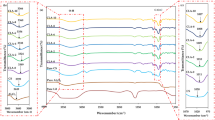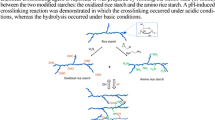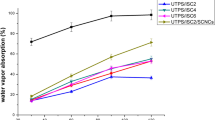Abstract
Biodegradable and natural rice starch (RS) polymer with lithium iodide salt (LiI) was used to prepare polymer electrolytes using solution cast technique. Polymer electrolyte films were characterized by thermogravimetric analysis (TGA), differential scanning calorimetry (DSC), X-ray diffraction (XRD), and scanning electron microscopy (SEM). TGA and DSC thermograms demonstrate that decomposition temperature (Tdc) and glass transition temperature (Tg) for rice starch shift upon complexation with lithium iodide salt. Thermolysis studies using TGA show decomposition temperature decreases with the addition of lithium iodide salt. XRD patterns show increase in amorphous behavior with doping of lithium iodide salt. The morphology studies were observed using SEM in terms of smoothness and miscibility.





Similar content being viewed by others
References
Choudhury NA, Ma J, Sahai Y (2012) High-performance and eco-friendly chitosan hydrogel membrane electrolytes for direct borohydride fuel cells. J Power Sources 210:358–365
Khanmrzaei MH, Ramesh S (2013) Ionic transport and FTIR properties of lithium iodide doped biodegradable rice starch based polymer electrolytes. Int J Electrochem Sci 8(7):9977–9991
Lenz, R. (1993). Biodegradable polymers. In R. Langer & N. Peppas (Eds.). Biopolymers I (Vol. 107, pp. 1–40): Springer Berlin Heidelberg.
Liew CW, Ramesh S, Ramesh K, Arof AK (2012) Preparation and characterization of lithium ion conducting ionic liquid-based biodegradable corn starch polymer electrolytes. J Solid State Electrochem 16(5):1869–1875
Lin CW, Liang SS, Chen SW, Lai JT (2013) Sorption and transport properties of 2-acrylamido-2-methyl-1-propanesulfonic acid-grafted bacterial cellulose membranes for fuel cell application. J Power Sources 232:297–305
Liu Y, Du BX, Du DM (2013) Pattern analysis on dielectric breakdown characteristics of biodegradable polyethylene film under nonuniform electric field. Int Trans Electr Energy Syst 23(1):72–82
Lörcks J (1998) Properties and applications of compostable starch-based plastic material. Polym Degrad Stab 59(1–3):245–249
Ma J, Sahai Y (2013) Chitosan biopolymer for fuel cell applications. Carbohydr Polym 92(2):955–975
Manindra Kumar TT, Srivastava N (2012) Electrical transport behavior of bio-polymer electrolyte system: potato starch + ammonium iodide. Carbohydr Polym 88(1):54–60
Maurizio Avella JJDV, Errico ME, Fischer S, Vacca P, Volpe MG (2005) Biodegradable starch/clay nanocomposite films for food packaging applications. Food Chem 93(3):467–474
Narpinder Singh JS, Kaur L, Sodhi NS, Gill BS (2003) Morphological, thermal, and rheological properties of starches from different botanical sources. Food Chem 81(2):219–231
Rahul Singh NAJ, Majumder S, Bhattacharya B, Singh PK (2013) Novel biopolymer gel electrolyte for dye-sensitized solar cell application. Carbohydr Polym 91(2):682–685
Ramesh S, Shanti R, Morris E (2013) Employment of Amim Cl in the effort to upgrade the properties of cellulose acetate based polymer electrolytes. Cellulose 20(3):1377–1389
Singh R, Jadhav NA, Majumder S, Bhattacharya B, Singh PK (2013) Novel biopolymer gel electrolyte for dye-sensitized solar cell application. Carbohydr Polym 91(2):682–685
Sownthari K, Suthanthiraraj SA (2013) Synthesis and characterization of an electrolyte system based on a biodegradable polymer. Express Polym Lett 7(6):495–504
Sudhakar YN, Selvakumar M, Bhat DK (2013) LiClO4-doped plasticized chitosan and poly(ethylene glycol) blend as biodegradable polymer electrolyte for supercapacitors. Ionics 19(2):277–285
Yoichi Tominaga, S. A., Masao Sumita, Stefania Panero, Bruno Scrosati. (2005). A novel composite polymer electrolyte: effect of mesoporous SiO2 on ionic conduction in poly(ethylene oxide)–LiCF3SO3 complex. Journal of Power Sources, 146(1–2), 402-404-406.
Zhang C, Zhu L, Shao K, Gu M, Liu Q (2013) Toward underlying reasons for rice starches having low viscosity and high amylose: physiochemical and structural characteristics. J Sci Food Agric 93(7):1543–1551
Acknowledgements
M. H. Khanmirzaei acknowledges the University of Malaya Bright Sparks Scheme (SBSUM) for the financial support (BSP 221(3)-12). This work was supported by the University of Malaya Research Grant (UMRG Program: RP001-2013A) and PPP Grant (PG105-2012B).
Author information
Authors and Affiliations
Corresponding author
Rights and permissions
About this article
Cite this article
Khanmirzaei, M.H., Ramesh, S. Studies on biodegradable polymer electrolyte rice starch (RS) complexed with lithium iodide. Ionics 20, 691–695 (2014). https://doi.org/10.1007/s11581-013-1031-x
Received:
Revised:
Accepted:
Published:
Issue Date:
DOI: https://doi.org/10.1007/s11581-013-1031-x




